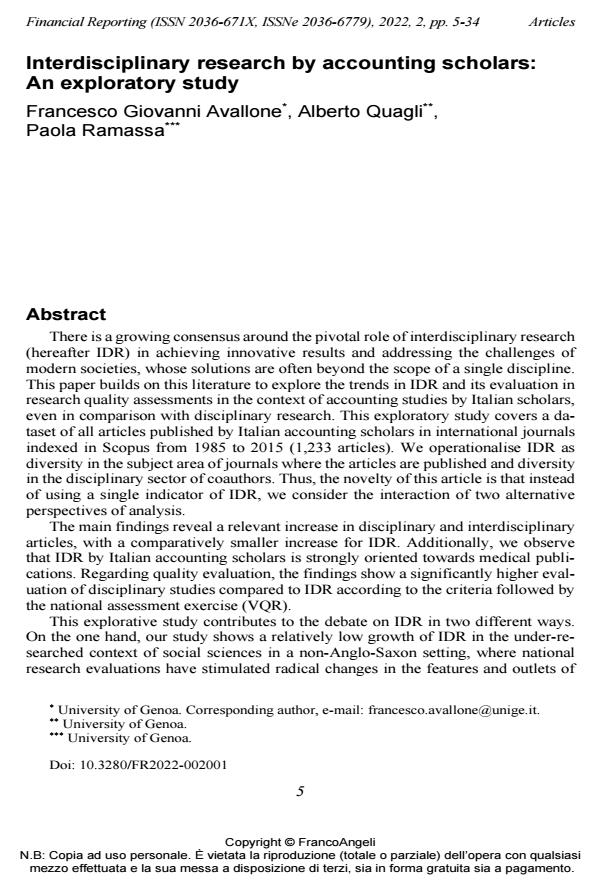Interdisciplinary research by accounting scholars: An exploratory study
Titolo Rivista FINANCIAL REPORTING
Autori/Curatori Francesco Giovanni Avallone, Alberto Quagli, Paola Ramassa
Anno di pubblicazione 2022 Fascicolo 2022/2
Lingua Inglese Numero pagine 30 P. 5-34 Dimensione file 209 KB
DOI 10.3280/FR2022-002001
Il DOI è il codice a barre della proprietà intellettuale: per saperne di più
clicca qui
Qui sotto puoi vedere in anteprima la prima pagina di questo articolo.
Se questo articolo ti interessa, lo puoi acquistare (e scaricare in formato pdf) seguendo le facili indicazioni per acquistare il download credit. Acquista Download Credits per scaricare questo Articolo in formato PDF

FrancoAngeli è membro della Publishers International Linking Association, Inc (PILA)associazione indipendente e non profit per facilitare (attraverso i servizi tecnologici implementati da CrossRef.org) l’accesso degli studiosi ai contenuti digitali nelle pubblicazioni professionali e scientifiche
There is a growing consensus around the pivotal role of interdisciplinary research (hereafter IDR) in achieving innovative results and addressing the challenges of modern societies, whose solutions are often beyond the scope of a single discipline. This paper builds on this literature to explore the trends in IDR and its evaluation in research quality assessments in the context of accounting studies by Italian scholars, even in comparison with disciplinary research. This exploratory study covers a da- taset of all articles published by Italian accounting scholars in international journals indexed in Scopus from 1985 to 2015 (1,233 articles). We operationalise IDR as diversity in the subject area of journals where the articles are published and diversity in the disciplinary sector of coauthors. Thus, the novelty of this article is that instead of using a single indicator of IDR, we consider the interaction of two alternative perspectives of analysis. The main findings reveal a relevant increase in disciplinary and interdisciplinary articles, with a comparatively smaller increase for IDR. Additionally, we observe that IDR by Italian accounting scholars is strongly oriented towards medical publi- cations. Regarding quality evaluation, the findings show a significantly higher eval- uation of disciplinary studies compared to IDR according to the criteria followed by the national assessment exercise (VQR). This explorative study contributes to the debate on IDR in two different ways. On the one hand, our study shows a relatively low growth of IDR in the under-re- searched context of social sciences in a non-Anglo-Saxon setting, where national research evaluations have stimulated radical changes in the features and outlets of scientific production. On the other hand, our results are consistent with the view that papers with a clear disciplinary focus receive comparatively higher evaluations be- cause the standards established for assessment are usually defined within the disci- pline.
Parole chiave:interdisciplinary research, interdisciplinary research measure, research quality evaluation, Italian accounting scholars.
Jel codes:M41, I23
- Elections and earnings management: Further evidence from Benford's law Francesco Capalbo, Luca Galati, in FINANCIAL REPORTING 2/2024 pp.105
DOI: 10.3280/FR2024-002005
Francesco Giovanni Avallone, Alberto Quagli, Paola Ramassa, Interdisciplinary research by accounting scholars: An exploratory study in "FINANCIAL REPORTING" 2/2022, pp 5-34, DOI: 10.3280/FR2022-002001